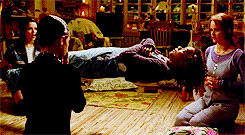 For my Deadly Games episode guide, click here
For my Deadly Games episode guide, click here
Good television, like a good movie or book, can leave you feeling sad once it’s over; as if something meaningful has come and gone in your life. Somewhere along the way you begin empathizing with the show’s characters, laughing at what they laughed at, crying at what made them weep. Their struggles resonate, leaving a diminishing echo once they’ve ended. I’ve known a few shows like this in my time, some popular and some not, and one of them is a hidden gem from 1995, called Deadly Games.
It may seem silly to assign such significance to a show involving video game characters come to life, but dig deep you’ll find what makes Deadly Games so special; it’s about wish fulfillment. Who hasn’t imagined standing up to that high school bully who beat you up, or impressing the girl who got away? These are the dreams of series protagonist Gus Lloyd, and can I easily relate.
Deadly Games only lasted twelve episodes, but it’s stuck with me for twenty years. Here’s why.
The BeginningDeadly Games began life as a rejected script making the rounds in Hollywood, about a video game bad guy brought to life. Viacom, who possessed the script, saw potential in the concept and asked eventual showrunner Paul Bernbaum to take a stab at it. Bernbaum, a writer with credits on the A-Team, 21 Jump Street, and Riptide, came back with several notes, including that the video game characters should be based on people from the hero’s life[1].
“The Girl” and “The Cold Steel Kid”
Bernbaum rewrote the script with collaborator Anthony Spinner (who’d co-create the show with Bernbaum and S.S. Schweitzer). Their story was about Gus Lloyd, a recently divorced physicist who spent his off hours programming a game which pitted him against villains modeled after people from his life. Reimagining himself as “The Cold Steel Kid,” Gus took on foes such as his icy ex-mother-in-law and hated boss. Accompanying him was “The Girl,” a beautiful love interest who just happened to look like his ex-wife, Lauren. Commanding these specters from Gus’s past was The Jackal, a debonair villain dressed in white whose goal was nothing less than to “destroy life as we know it.”
Gus’s game would have remained his own private therapy if it weren’t for a convenient lab accident, which granted life to Jackal and his legion. They see Gus as his digital counterpart, and to her great exasperation, Lauren as hers. This unbelievable situation reunites a still infatuated Gus with his assertive ex-wife, and the two reevaluate their relationship while saving the world.

Leonard Nimoy
The script eventually found itself on the desk of Leonard Nimoy, best known as the logical Mr. Spock from Star Trek. Nimoy had found success as a Hollywood director, helming such hits as Star Trek IV: The Voyage Home and Three Men and a Little Baby, but taking on Deadly Games would be his only producer credit on a television show. He was attracted to its unpretentious and jaunty tone, and saw great comedic potential in having the villains be from the neurotic Gus’s life. He was also fascinated by the relationship between Gus and Lauren, whose strained reunion would ground the show’s more fantastical elements[2].
When Nimoy joined the show, it was being developed as a six-episode limited series, tracking Gus and Lauren’s adventures from the birth of Jackal to the reveal of his progenitor. Unfortunately, the series couldn’t find a home[3].
“When we finished the six scripts, they went to ABC, who decided to put it in turnaround” Nimoy told Starlog’s Bill Warren. He continued that despite the setback “a series of various possibilities came along. They came to me and asked if I wanted to do it as a two-hour television movie, and I said I wasn’t really interested in doing that. I thought the concept needed progression, that it needed more than a two-hour show to tell the story successfully. To telescope everything into one show wasn’t appealing[4].”
 Thankfully, a network eventually showed interest in the series; the beleaguered United Paramount Network (UPN)[5]. Despite a promising start with the highly rated premiere of Star Trek: Voyager[6], it was unable to find success in the rest of its line-up. Canceling everything but Voyager after its first season[7], UPN planned to fill its slate with dramas and action series, including Deadly Games. The network gave the show a surprise 13-episode commitment and placed it at 8PM Tuesday.
Thankfully, a network eventually showed interest in the series; the beleaguered United Paramount Network (UPN)[5]. Despite a promising start with the highly rated premiere of Star Trek: Voyager[6], it was unable to find success in the rest of its line-up. Canceling everything but Voyager after its first season[7], UPN planned to fill its slate with dramas and action series, including Deadly Games. The network gave the show a surprise 13-episode commitment and placed it at 8PM Tuesday.
Deadly Games was finally ready to play.
Character SelectA high concept series like Deadly Games lives or dies by its leads. For an audience to believe computer programs can become flesh, it needs to care about the characters who are dealing with them. Do we like these people, and do their struggles with digital boogiemen say something interesting about them?

James Calvert as Gus Lloyd
For Gus Lloyd, the producers went through several candidates before deciding on James Calvert, who starred in the late 1980s Superboy TV-series as Perry White’s son, T.J. It was important to Nimoy that they find someone youthful enough to convey Gus’s lovelorn ways, but also believable as a scientist. “Some guys would be extremely neurotic, but you couldn’t buy that they had any sexuality in them. We were lucky to finally find James Calvert, who read the role intelligently, made sense and had a sense of humor[8]“.
Getting Gus right was vital to the show’s success. It’d be easy to mock a character so repressed that he designs computer villains after the likes of his garbage man, and his fixation on Lauren could be seen as creepy. Calvert’s boyish innocence makes these traits relatable instead of off-putting, and he proves a capable series lead.

Cynthia Gibb as Lauren Ashborne
Equally important was the beneficiary of Gus’s affection, Lauren Ashborne. The show cast Cynthia Gibb, who had 15 successful years of television and movie work behind her. Said Nimoy, “We all had seen her work and liked it.” He’d go on to say that “She’s energetic, she has a kind of perky quality about her—though I hate to use that word—a lot of charm, very sophisticated, a kind of hip awareness about herself and what’s going on about her, which I think Lauren can use[9].”
In describing Lauren, its best to quote her alter-ego. “Lauren is a sharp-witted, strong-willed journalist who’s a bit cynical and sarcastic, very independent. She’s bright, concise, and witty[10].” Lauren is the glue of the show, acting as a viewer surrogate while maintaining her own strong personality. She typically reacts to Gus with wry humor, and quickly cuts through his pretentions about the game. This isn’t to say she doesn’t get in over her head; she can’t resist getting cocky with Jackal, which causes her and Gus trouble on more than one occasion.
Though Deadly Games is nominally about video game bad guys, its true heart lies between Gus and Lauren. Though the series begins with Gus literally ruining her wedding day, Lauren takes quickly to being back in her ex-husband’s life. They make a good team, with Calvert and Gibb sharing an effortless chemistry. It’d be easy for the acerbic Lauren to seem nasty, or the lovelorn Gus to be viewed as pathetic, but their empathy for one another makes them a sympathetic couple.

Christopher Lloyd as Sebastian Jackal
Not sympathetic, but incredibly entertaining still, is the “The Cold Steel Kid’s” arch nemesis, Sebastian Jackal. Jackal is a suave sadist who dresses in an elegant white suit and drives an elegant white Chrysler, and each week sends a foul figure from Gus’s past to defeat him. He rarely gets his hands dirty, preferring to chaperone his minions while taunting Gus and Lauren with sardonic glee. He’s a larger than life character, one that Christopher Lloyd nails.
Lloyd had signed on for the first six episode, which tells the full arc of Jackal’s story, but so enjoyed the role that he kept with the series[11]. Though they could have found a better way to extend the character’s stay, the benefits of retaining Lloyd outweighed any faults. Jackal’s presence is vital to the “villain of the week” formula, as he often enhances the presence of less charismatic opponents. He has a great rapport with James Calvert; oozing a condescending smarm whenever addressing his cocksure adversary. This is one of his best performances, on par with Doc Brown and Jim Ignatowski.

Stephen T. Kay as Peter Rucker
Rounding out the cast is Stephen T. Kay as Gus’s lab partner, Peter Rucker. Peter is a Chandler-esque, Gen-X wisecracker from Queens who helps Gus reprogram the game, and researches where Jackal will strike next. According to Kay, the character was supposed to be more of a stereotypical computer nerd, but he and the producers made him more hip after reading a magazine article about modern computer users[12].
There isn’t much to say about Peter; he’s more a plot device than a character for most of the run. Kay is game, and when caught between a bickering Gus and Lauren Peter can be amusing, but otherwise he’s just the token “hip” character. He even has his own catch phrase; after stating a fact or opinion he’ll say “Am I right or am I right? Don’t give me right if I’m not right.” Near the end of the series he does get more to do, and is given a foil in the person of an L.A. police detective investigating Gus and Lauren. Had the show continued, he would have confessed a secret crush on Lauren[13].
The Game’s Afoot
“Level One, Kid.”
On Tuesday, September 5, 1995, the premiere episode of Deadly Games aired. Titled “Killshot,” it pitted Gus and Lauren against the newly born Jackal for the first time. The instrument of Jackal’s mayhem was Killshot, a hulking monster based on a bully Gus suffered in high school. Once come to life, Killshot seeks “The Girl,” who he’s programmed to kidnap before stealing a nuclear warhead. This could have come at a better time for Lauren, whose about to get remarried.
“Killshot” sets the formula of the series, which take the form of rules Gus programmed into the game. The villains that Jackal unleash all have unique back stories, goals, weaknesses, and methods of defeat. In the case of Killshot, the evil jock plans to bomb a football stadium as revenge for being cut from a football team. His kryptonite is water, due to Killshot’s supposed jealousy of Gus’s swim team performance. (Lauren refers to this as Gus’s “pathetic little way of getting even.”) Squirting Killshot will cause him burning pain, making him howl like Frankenstein’s monster. To kill the lug, he needs to be dumped into a lake or other large body of water.

Tom Rathman as “Killshot”
Though brought to life, the villains have no free will and are bound by their programming. Gus knows what steps they’ll take, but because they aren’t in a perfectly planned game environment he doesn’t always know where; he has to intuit their targets based on the quirky logic Gus gave Jackal. For instance, in the next episode Gus and Lauren are trying to find a villain based off Lauren’s mother, who Gus considers a witch. They locate her on the S.S. Maxwell cruise ship, because the actress who played the Wicked Witch from The Wizard of Oz was a spokesperson for Maxwell House coffee.
Straightforward, right?
“Killshot” has the burden of carrying a lot of exposition, but carries it well. More impressive is how perfectly it established Gus and Lauren and their dynamic. There’s a wonderful scene where Gus does his best to comfort a scared Lauren, assuring her they were safe until morning. Lauren goes to bed, hugging a super soaker while Gus places a blanket over her. Gus, ever affectionate, sits by her bed while she closes her eyes and begins leaning in to kiss her on the cheek, only for Lauren to deadpan “back off, Gus.” They care and trust each other, but one of them is obviously trying to move on.

Gus and Lauren
“Killshot” is an enjoyable piece of television. The central premise is fun in its outlandishness, yet never laughable. Much of this, again, has to do with Gus and Lauren. Lauren brings so much skepticism to the proceedings that it forces Gus to admit the sillier (or pettier) aspects of their circumstances. This show knows what it is, makes no excuses, and has a great time doing it. Our heroes aren’t two-dimensional caricatures, and bring a lot of heart to the proceedings. And Christopher Lloyd is his usual awesome self.
Unfortunately, the reviews for the premiere were mixed to negative. Variety gave it a good write-up, praising the concept, Lloyd’s performance, and the potential for Moonlighting-style chemistry between Gus and Lauren[14]. People Magazine, meanwhile, assigned it a ‘C,’ suggesting it was too “long-winded” and “rinky-dink[15].” Less charitable were The Orlando Sentinel and L.A. Times, who both found issue with the series’ concept and acting[16].
Ratings-wise, the show wasn’t the success UPN hoped for. The premiere was watched by 3.5 million people, with a Nielsen rating of 2.6; it would average these for the entire run. This is on par with Richard Dean Anderson’s “Legend,” which Deadly Games replaced, but a couple million less than Richard Greco’s “Marker,” the originator of UPN’s 8PM Tuesday timeslot. It’s worth noting that Star Trek: Voyager had a similar drop, from roughly ten million viewers an episode to eight million[17].
Despite the lukewarm reception, Deadly Games was finally on the air, and was telling the story it wanted to tell.
Game LevelsThe first part of Deadly Games season was a truncated version of the planned mini-series, with two of the six episodes moved to the latter-half of the show’s run. The next couple episodes following “Killshot” would continue its formula, featuring bad guys played by name actors, and the fourth episode would be a showdown between “The Cold Steal Kid” and Jackal.
LeVar Burton as “Mr. Metcalf”
Killshot was played by L.A. Raiders’ full back Tom Rathman, whose casting was made part of the show’s publicity. The next episode, Shirley Jones (The Partridge Family) played both Lauren’s mother and her digital doppelganger, who could freeze anything she touches. Following her was Star Trek: The Next Generation’s LeVar Burton as an exploding pink slip firing boss from hell. Burton would be the first of several Star Trek alumni to assume roles on the series, casting which was encouraged (but not dictated) by the network[18]. Later episodes would have Michael Anthony Hall, Brent Spiner, and Dwight Shultz portraying Jackal’s subordinates. Jerry Stiller, Kathy Ireland, Jimmie Walker, and Downtown Julie Brown would guest star in other roles, as would a young Jeremy Renner.
These first few episodes saw the nascent bond between Gus and Lauren take shape, as both adapted to their roles as action heroes. Peter, meanwhile, futzed with the game in hopes of deleting Jackal and the other bosses. He achieves success in the fourth episode, “The End of Jackal,” but brought down Jackal’s wrath before sealing his defeat.
Dressed to kill
In the episode, Jackal becomes infuriated after Gus deletes his underlings, and begins playing out his own final level. His goal is to destroy the concept of family, and begins targeting parks and maternity wards. Meanwhile, Gus has pushed Lauren away after an attempt to reconcile him with his father. Lauren fears Gus has forever moved past her, giving us one of the first hints she still has feelings for him. At the episode’s end, while the two and Jackal trade fire in a digital hospital, Gus reveals the man in white is modeled after his disapproving father.
The planned mini-series was meant to build suspense as to Jackal’s identity, but two integral episodes were not aired before the reveal, blunting some of the impact. In fact, having “The End of Jackal” air as episode four of twelve negatively affected the series. Short of a tacked on 30 seconds, the show arguably ended with this episode. The program was deleted, and Gus reunited with his father. The only unresolved thread was the Gus/Lauren relationship, but with her at his side when meeting his father, there was little doubt to where it was going.
Now with further episodes to film, and renewed interest from Christopher Lloyd, Deadly Games had to perform a game reboot. Jackal, who recovered his own file somehow, sends out a bad guy to torment Gus while he continues plotting his escape from the computer. This leads to an unnecessary two-part episode where Gus and Lauren are back on the road hunting a deranged camp counselor, accompanied by a digital Kathy Ireland (who Gus had programmed into the game). By the second part Jackal is back in the real world, heckling Gus while supervising his minion.
Sebastian Jackal and Gus Lloyd
This latter half of the series has a different vibe than the first. Gus claims to now be immune to Jackal’s tricks; a possible acknowledgement of him reconciling with his father. This is unfortunate, as it makes Jackal a less resonate character (though no less entertaining). While there is fertile ground for storytelling with him (such as exploring the self-awareness he has that the other programs don’t), the remainder of the series is happy to leave him as a sardonic figure forever taunting Gus.
For the better was the Gus and Lauren relationship, which really began to flourish. In the two-part episode, “The Camp Counselor,” Jackal manages to pull Lauren into the computer, holding her hostage until Gus and Peter recreate the accident and free him. This selfless act (which could doom the world) breaks through Lauren’s defenses, and the two share the first of several tender moments in the remaining episodes. She becomes less ambivalent and cynical, and more engaged in the problem solving. It’s so gratifying to watch the two just sit and discuss an enemy’s motivation, without any snark from Lauren. In the final episode, Lauren acknowledges she has feelings for Gus, but wants to wait until they’re certain it isn’t just the heat of the moment.
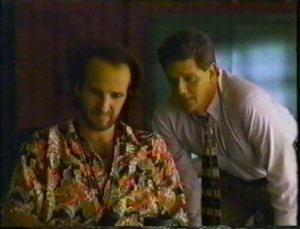
Peter and Detective Dorn
These episodes alsointroduce Detective Dorn, a Los Angeles police officer with a cringe worthy sense of humor. He comes to suspect that Gus, Lauren, and Peter are role playing the game, and everything that’s happened is a destructive hoax. Dorn confronted them more than once, slinging non-sequiturs as a way of rattling them. He’s a good character, and a great partner for Peter, but his quirky behavior is somewhat grating.
Cracks in the series concept began to form near the end of its run. The “villain of the week” concept was becoming stale, with bad guys based on garbage men and car mechanics, of all people. There was one episode that tried breaking the show’s formula, “The Practical Joker,” but it was a complete flop. It featured The Next Generation star Brent Spiner (who played the android Data) as a villain snuck into the game by Gus’s old colleague, whose programming caused him to drug Lauren and Peter, place them unclothed into bed, and call “The Cold Steel Kid” to say they slept together. It was a surprisingly cruel plotline that didn’t jive with the tone of the series.
The episode also featured who I like to called “Petulant Gus.” Several episodes portrayed Gus as a possessive jerk, going into moody fits because Lauren pushed him to reunite with his dad, or kept an undisclosed bank account from him during their marriage. What’s worse, Lauren would placate him with apologies he didn’t deserve (She did bite back in “The Practical Joker”). It was sad she felt it necessary, and if this is how he typically behaved it’s understandable why they got divorced. Thankfully, this portrayal was an aberration contrary to the rest of the series.
Movie date night with “Dr. Kramer” and Jackal
The first six episodes of the season, despite skipping a couple installments, were told in production order and made sense. The final half, for whatever reason, jumbled that order. This has a detrimental effect on the Gus and Lauren story, which inexplicably goes from her admitting her feelings one week to acting distant the next. The final episode aired was meant to be the third, meaning Lauren acts with the same annoyance and sarcasm towards Gus that she did in the premiere. This is disappointing, but once you take the production order into account it’s a much-improved story progression. The final production episode aired, “The Car Mechanic,” offers a small amount of closure for the Gus and Lauren story. It’s not much, but I’ll take it.
Game OverDeadly Games aired its final episode on January 16, 1996, ending one episode short of the planned 13. Replacing it was the popular sitcom Moesha at 8PM, starring R&B singer Brandy, and the soon canceled Minor Adjustments at 8:30PM[19]. There are some sources that claim the 13th episode, entitled “The Ex-Girlfriend,” aired a year later, but I haven’t found any solid evidence
Cynthia Gibb, James Calvert, and Stephen T. Kay never starred in another television series. Gibb maintained an active career doing movies and TV guest spots[20], while James Calvert’s career began to wind down[21]. Stephen T. Kay would shift his talents behind the scenes, wearing many different hats. He wrote the 1999 film adaptation of The Mod Squad series, helmed the 2000 Sylvester Stallone vehicle Get Carter, and directed episodes of series such as The Shield, Sons of Anarchy, and Quantico[22]. Christopher Lloyd continues to be a much-sought after talent[23].

Cynthia Gibb in A Family Lost (2007), James Calvert on 24 (2005), Stephen T. Kay directing an episode of Covert Affairs (2013), and Christopher Lloyd in Going in Style (2007)
After Deadly Games, Paul Bernbaum would write the George Reeves biopic Hollywoodland and Nicholas Cage film Next, and contribute to the Disney Channel original series Halloweentown[24].
UPN remained a broadcast network for the next ten years, airing cult TV series such as Veronica Mars[25], Roswell, and the later seasons of Buffy: The Vampire Slayer[26]. In 2006, it merged with competitor, The WB, to become The CW network[27].
Leonard Nimoy stopped producing television and film after Deadly Games, and most of his acting credits afterwards were as a voice-over artist. In 2009, he returned to the role that made him famous in J.J. Abram’s Star Trek reboot, and had a recurring role in the director’s TV series, Fringe[28]. Ever the renaissance man, Nimoy became a respected photography during the new millennium, with works that explored his Jewish faith[29], and challenged society’s standards for female beauty[30]. He passed away on February 27, 2015, at the age of 83[31].
ConclusionI was 14 when Deadly Games first aired, and didn’t come to it immediately; it took a combination of things to eventually draw my attention. I knew it was about video games, and it starred Christopher Lloyd, who I adored from Back to the Future and Taxi, but it was probably the Star Trek connection that won me over; I recall Brent Spiner’s guest turn as a highlight in commercials during Star Trek: Voyager. The episode itself wasn’t wonderful, but still had a glimmer of what made the show great. Thankfully, I tuned in the next week to a much better episode.
 It’s easy to be sarcastic about a show like Deadly Games. The concept is far-fetched, its tenuous grasp on video games is amusing, and how the game characters come to life doesn’t hold up to scrutiny. Yet, you needn’t dig too deep to see the real value of the show. The acting, the writing, the cleverness, the fun; it’s all there in the first episode. The relationship between Gus and Lauren, that I’ve mentioned so many times, is very special. I’ll admit I’m a hopeless romantic, but not what you’d call a ‘shipper.’ Still, I couldn’t help but root for these two. Gus was right to still be infatuated; there’s definitely a fire between them that hadn’t gone out.
It’s easy to be sarcastic about a show like Deadly Games. The concept is far-fetched, its tenuous grasp on video games is amusing, and how the game characters come to life doesn’t hold up to scrutiny. Yet, you needn’t dig too deep to see the real value of the show. The acting, the writing, the cleverness, the fun; it’s all there in the first episode. The relationship between Gus and Lauren, that I’ve mentioned so many times, is very special. I’ll admit I’m a hopeless romantic, but not what you’d call a ‘shipper.’ Still, I couldn’t help but root for these two. Gus was right to still be infatuated; there’s definitely a fire between them that hadn’t gone out.
This romance is emblematic of the show’s greatest strengths, earnestness and heart. It doesn’t make fun of its own premise, or disrespect its audience. It’s not Shakespeare, but isn’t trying to be. It wants you to care for its characters, and if you give the show an honest chance you will.
Deadly Games has a lot of heart, and heart is what makes this game worth playing.
References: [1] pg. 46-47, “Deadly Gamesters”, Starlog #219 (Oct. 1995) [2] pg. 47, “Deadly Gamesters”, Starlog #219 (Oct. 1995) [3] pg. 45, “Deadly Gamesters”, Starlog #219 (Oct. 1995) [4] pg. 45, “Deadly Gamesters”, Starlog #219 (Oct. 1995) [5] pg. 45, “Deadly Gamesters”, Starlog #219 (Oct. 1995) [6] http://www.nytimes.com/1995/01/18/arts/new-star-trek-helps-new-network.html) [7] http://www.nytimes.com/1995/05/18/arts/upn-network-cancels-3-of-its-4-programs.html) [8] pg. 48, “Deadly Gamesters”, Starlog #219 (Oct. 1995) [9] pg. 48, “Deadly Gamesters”, Starlog #219 (Oct. 1995) [10] pg. 52, “Deadly Rose”, Starlog #221 (Dec. 1995) [11] pg. 48, “Deadly Gamesters”, Starlog #219 (Oct. 1995) [12] pg. 48, “Playing Games”, Starlog #220 (Nov. 1995) [13] pg. 54, “Deadly Rose”, Starlog #221 (Dec. 1995) [14] “Review: Deadly Games”, Tom Bierbaum, Variety (Sept. 6, 1995) [15] http://people.com/archive/picks-and-pans-review-deadly-games-vol-44-no-10/ [16] “A Promising Idea Goes Awry in UPN’s ‘Deadly Games’, Howard Rosenberg, Los Angeles Times (Sept. 5, 1995) “Deadly Games”, Hal Boedeker, Orlando Sentinel (Sept. 5, 1995) [17] http://anythingkiss.com/pi_feedback_challenge/Ratings/19941205-19950305_TVRatings.pdf http://anythingkiss.com/pi_feedback_challenge/Ratings/19950306-19950528_TVRatings.pdf http://anythingkiss.com/pi_feedback_challenge/Ratings/19950529-19950917_TVRatings.pdf http://anythingkiss.com/pi_feedback_challenge/Ratings/19950918-19951126_TVRatings.pdf http://anythingkiss.com/pi_feedback_challenge/Ratings/19951127-19960225_TVRatings.pdf [18] pg. 48, “Deadly Gamesters”, Starlog #219 (Oct. 1995) [19] http://anythingkiss.com/pi_feedback_challenge/Ratings/19951127-19960225_TVRatings.pdf [20] http://www.imdb.com/name/nm0001269/ [21] http://www.imdb.com/name/nm0130808/ [22] http://www.imdb.com/name/nm0443181/ [23] http://www.imdb.com/name/nm0000502/ [24] http://www.imdb.com/name/nm0076602/ [25] “A Junior Detective at Hard-Boiled High,” Alessandra Stanley, The New York Times (Sept. 20, 2004) [26] “TV NOTES; Lapping Up Normalcy,” Jim Rutenberg, The New York Times (Oct. 10, 2001) [27] http://www.nbcnews.com/id/11006886/ns/business-us_business/t/cbs-warner-bros-forming-new-tv-network/ [28] http://www.imdb.com/name/nm0000559/ [29] http://www.rmichelson.com/artists/leonard-nimoy/shekhina/ [30] http://www.rmichelson.com/artists/leonard-nimoy/the-full-body-project/ [31] “Leonard Nimoy, Spock of ‘Star Trek,’ Dies at 83,” Virginia Heffernan, The New York Times (Feb. 27, 2015)” Advertisements Share this:


